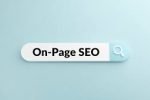Did you know that On-Page SEO is the foundation of your website’s ranking success? You could have the best content, but without proper SEO optimization, search engines might never find it! 😱
If you want to rank higher, attract more traffic, and convert visitors into customers, you need to master On-Page SEO. Let’s dive into the essential elements that make or break your website’s search engine rankings!
1️⃣ Keyword Optimization – The Backbone of SEO
🔎 Search engines rely on keywords to understand your content. But keyword stuffing? ❌ That’s a thing of the past! Instead, use natural keyword placement throughout your:
✅ Title tags & meta descriptions
✅ Headings (H1, H2, H3)
✅ URL structure
✅ Image alt texts
✅ Content body
🔗 Learn More: How to Write SEO-Friendly Content for Your Website
2️⃣ Compelling Title Tags & Meta Descriptions
Your title tag and meta description are the first things users see in search results. If they’re not compelling, your click-through rate (CTR) will suffer!
🚀 Best Practices:
✅ Keep titles under 60 characters
✅ Include primary keywords naturally
✅ Write meta descriptions under 160 characters
✅ Add a call-to-action (CTA) to boost clicks
Example:
✅ Good Title: “10 On-Page SEO Strategies to Boost Your Google Rankings!”
❌ Bad Title: “SEO Tips for Better Website Performance”
🔗 Learn More: How Do Keywords in Meta Titles and Descriptions Improve SEO?
3️⃣ Header Tags (H1, H2, H3) for Better Readability
🚀 Imagine reading a long, unformatted article—boring, right? Header tags improve readability and help search engines understand your content structure.
✔ H1 = Main Title (Use only one per page)
✔ H2, H3, H4 = Subheadings (Organize content logically)
🔥 Pro Tip: Use keywords in your headers to improve SEO!
🔗 Learn More: The Role of Headers (H1, H2, H3) in On-Page SEO
4️⃣ Internal Linking – Connect the Dots!
Want to keep visitors on your site longer? ⏳ Internal links guide users to other valuable pages on your website, improving user experience and SEO rankings.
✅ Link to relevant pages naturally
✅ Use descriptive anchor text
✅ Avoid too many links in one post
Example:
🔗 Instead of saying “Click here,” say “Check out our guide on On-Page SEO best practices.”
🔗 Learn More: How to Use Internal Linking Effectively for SEO
5️⃣ Image Optimization – A Hidden SEO Goldmine!
Did you know Google Image Search can drive massive traffic to your website? Optimize your images for speed and SEO by:
✔ Using compressed images (JPEG, PNG, WebP)
✔ Adding descriptive alt text with keywords
✔ Naming files properly (e.g., on-page-seo-tips.jpg instead of IMG1234.jpg)
🔥 Bonus: Fast-loading images improve page speed, which boosts rankings!
🔗 Learn More: How Do Images Contribute to On-Page SEO?
6️⃣ Page Speed & Mobile Friendliness – No One Likes a Slow Site!
If your site takes more than 3 seconds to load, 50% of visitors will leave! 😨 Google also prioritizes fast, mobile-friendly websites.
🚀 Speed Optimization Tips:
✅ Enable browser caching
✅ Compress images & videos
✅ Minify CSS & JavaScript
✅ Use AMP (Accelerated Mobile Pages)
🔗 Learn More: How to Optimize Your Website’s Loading Speed for SEO
7️⃣ URL Structure – Keep It Clean & Simple
Would you rather click on:
❌ www.example.com/post/1234abc?=xyz
✅ www.example.com/on-page-seo-guide
A clean, keyword-rich URL improves both SEO and user experience! 🚀
💡 Best Practices:
✔ Keep URLs short & readable
✔ Use hyphens (-) instead of underscores (_)
✔ Include primary keywords
🔗 Learn More: How to Optimize Long-Tail Keywords on Your Website
Final Thoughts: Why On-Page SEO is a Must!
Without On-Page SEO, even the best content can go unnoticed. But by optimizing your keywords, headings, internal links, and page speed, you’ll improve your Google rankings and drive more organic traffic! 🚀
Need Expert Help with SEO?
At Social Media Max, we specialize in On-Page SEO, Web Development, and Digital Marketing. Call us at 0161 399 3517 or email Syed_66@hotmail.com to get started!

